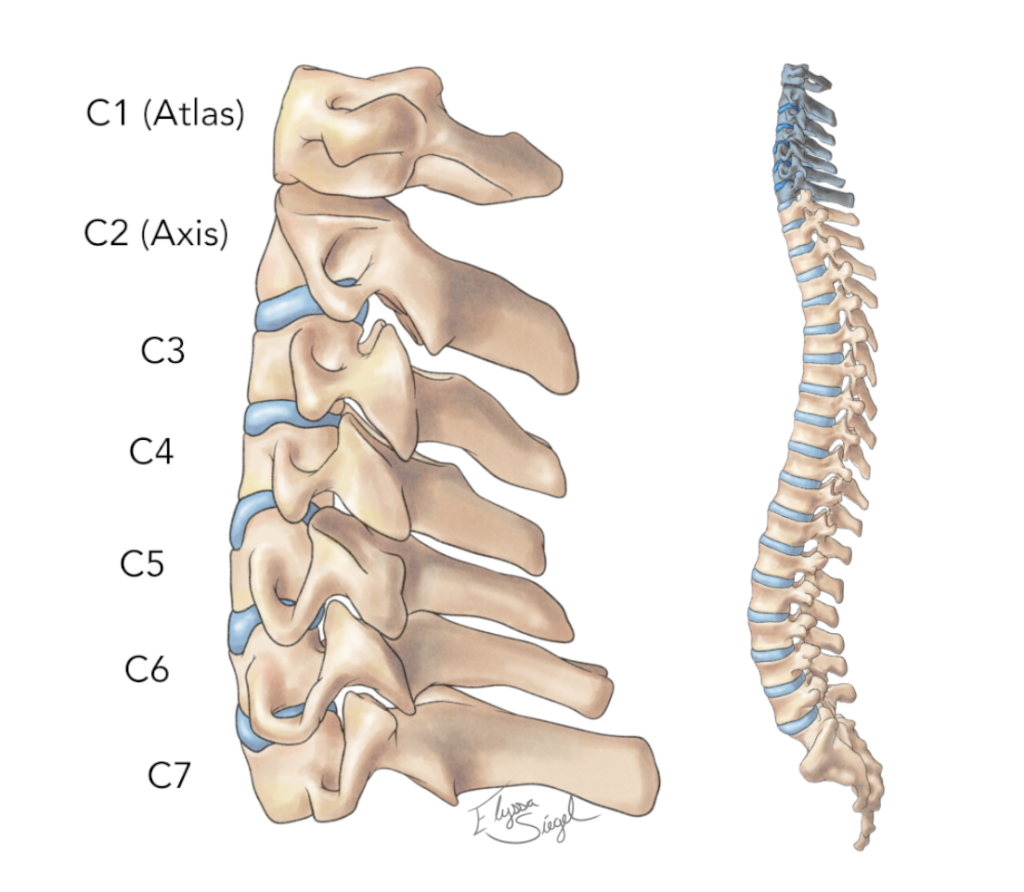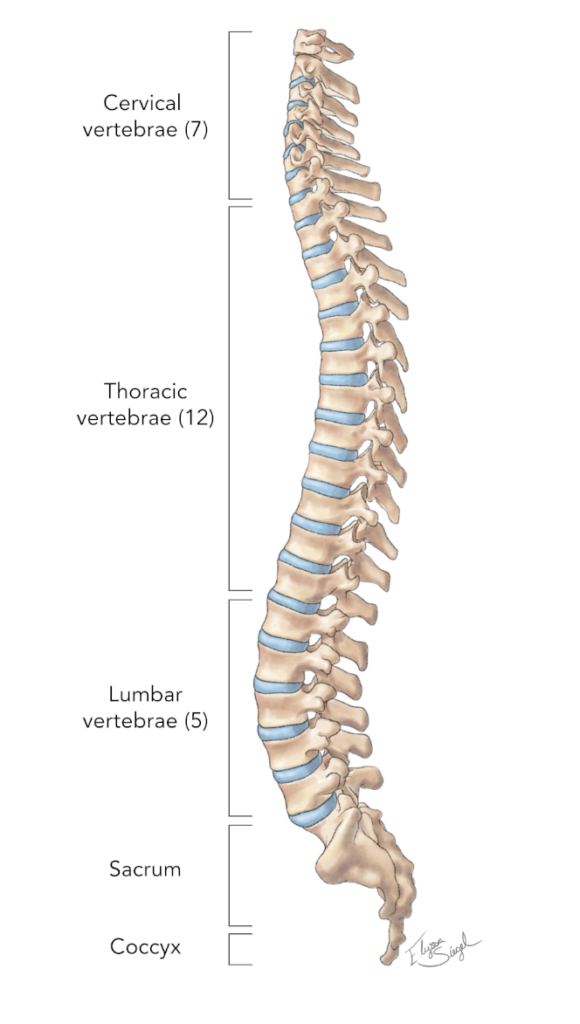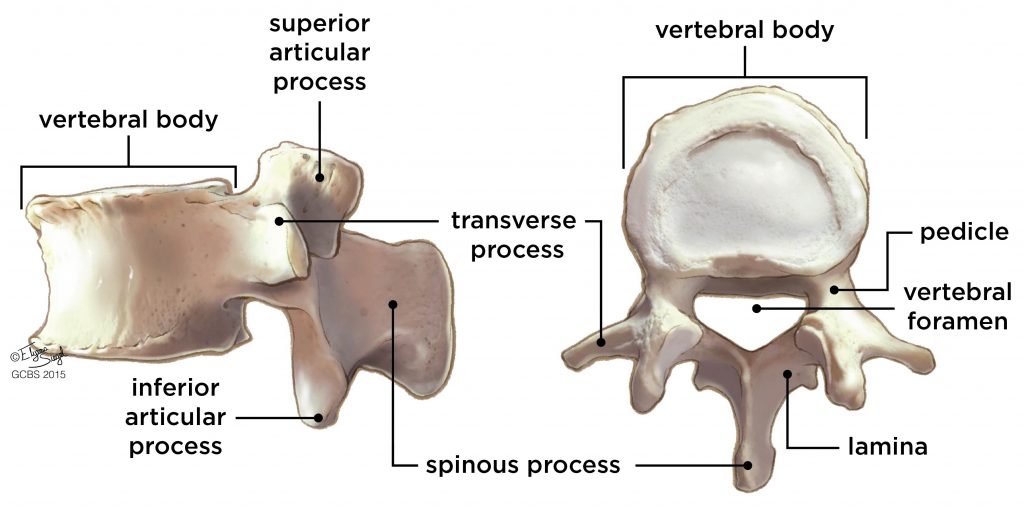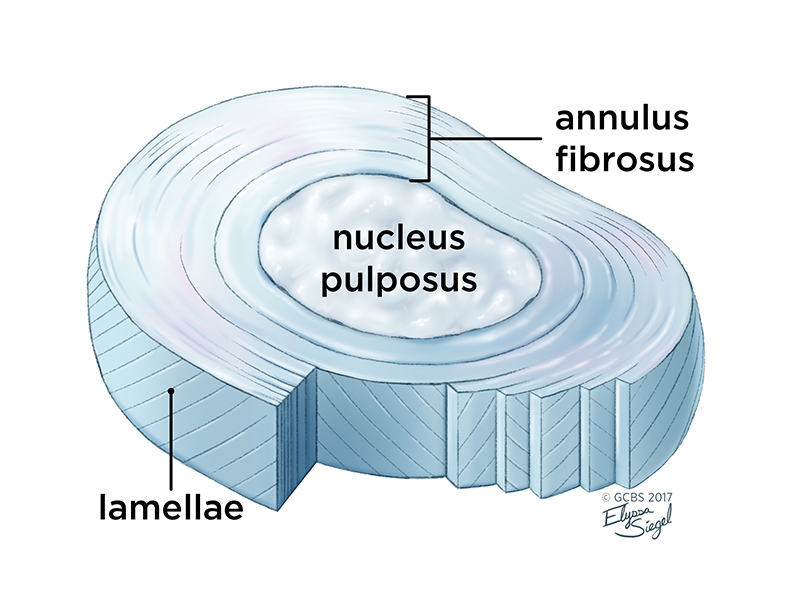Spine Anatomy
The spine is a very complex mechanical structure that is highly flexible yet very strong and stable. In the normal spine, regardless of your position or activity, including sleeping, there is always some type of physical demand being placed on it.
The primary functions of the spine include:
- Protecting the spinal cord, nerve roots and internal organs
- Providing flexibility of motion
- Providing structural support and balance for upright posture. The spine bears the load of the head, shoulders and arms and upper body. The upper body weight is then distributed to the hips and legs. The spine attempts to keep the body’s weight balanced evenly over the pelvis. This reduces the amount of work required by the spinal muscles and can eliminate muscle fatigue and back pain.
The normal adult spine is balanced over the pelvis, requiring minimal workload on the muscles to maintain an upright posture.
Loss of spinal balance can result in strain to the spinal muscles and deformity of the spine as it attempts to maintain an upright posture.

Regions of the Spine
There are 33 vertebrae, or bones, in the spine. These bones are divided into four regions.
Beginning at the neck and moving down the spine, they are the cervical, thoracic, lumbar, sacrum and coccyx vertebrae.
- Cervical (neck)- the top seven vertebrae/bones are called C1-C7.
- Thoracic (upper back)- the next 12 vertebrae/bones are called T1-T12.
- Lumbar (lower back)- the next five vertebrae/bones are called L1-L5.
- The sacrum and coccyx (tailbone) are made up of nine vertebrae/bones that have fused together.
Spinal curves
When viewed from the front or back, the normal spine is in a straight line, with each vertebra sitting directly on top of the other. A side-to-side curve in the spine is called scoliosis.
When viewed from the side, the normal spine has three gradual curves:

- The neck has a lordosis; it curves toward the back.
- The thoracic spine has a kyphosis; it curves toward the front.
- The lumbar spine also has a lordosis.
These curves help the spine support the load of the head and upper body and maintain balance in the upright position.
Vertebrae
Although the vertebrae have slightly different appearances as they range from the cervical spine to the lumbar spine, they all have the same basic structures, and the structures have the same names. Only the first and second cervical vertebrae are structurally different in order to support the skull.

Each vertebra has an anterior arch and a posterior arch, which form a hole, called a foramen. The spinal cord passes through foramen of each vertebra.
The anterior arch is called the vertebral body. Discs separate one vertebral body from another, allowing motion of the spine and cushioning it against heavy loads. Together, the vertebral bodies and discs bear about 80% of the load to the spine.
Intervertebral discs
Intervertebral discs are located between each vertebra from C2-C3 to L5-S1. Combined, they make up one fourth the height of the spinal column. The discs act as shock absorbers to the loads placed on the spine and allow movement of the spine. Movement at a single-disc level is limited, but all of the vertebrae and discs combined allow for a significant range of motion.
The intervertebral disc is made up of two components: the annulus fibrosus and the nucleus pulposus. The annulus fibrosus is the outer portion of the disc. It is composed of layers of collagen and proteins called lamellae. The fibers of the lamellae slant at 30-degree angles, and the fibers of each lamella run in a direction opposite the adjacent layers. This creates a structure that is exceptionally strong, yet extremely flexible.

The nucleus pulposus is the inner gel material surrounded by the annulus fibrosus. It makes up about 40% of the disc. This ball-like gel is contained within the lamellae. The nucleus is composed primarily of loose collagen fibers, water and proteins. The water content of the nucleus is about 90% at birth and decreases to about 70% by the fifth decade.
Injury or aging of the annulus fibrosus may allow the nucleus pulposus to be squeezed through the annulus fibers either partially, causing the disc to bulge, or completely, allowing the disc material to escape the disc. The bulging disc or nucleus material may compress the nerves or spinal cord, causing pain.
In the early years of life, the discs have a blood supply that nourishes them. In the second and third decades, discs gradually lose this blood supply until they are avascular. At this point, the discs begin to degenerate, or age. By the age of 50, over 95% of all people will have disc degeneration. The disc begins to lose water content and shrinks. The spine’s range of motion and shock-absorbing ability are decreased. This may result in injury to the nerves and vertebrae, and the aging disc itself may generate pain.
Spinal cord
The brain and spinal cord together make up the central nervous system. The spinal cord is located immediately below the brain stem. It extends through the foramen magnum, a hole at the base of the skull.
The spinal cord functions as a sophisticated network that carries information from the outer elements of the body (skin, muscles, ligaments, joints) through the sensory tracts, to the central “computer,” the brain. Data are processed there, and new information such as muscle control is sent out through the motor tracts of the spinal cord.
The spinal cord ends as the conus medullaris at the L1 vertebral level, where it branches into the cauda equina, a collection of nerves that extend from the conus medularis to the sacrum. The conus medularis nerves float freely in spinal fluid, making it possible to pass a needle safely into the area to draw a sample of spinal fluid or inject drugs, anesthetics or radiological substances for x-ray, MRI or CT scan.
Conditions
Request an appointment online and we will guide you through the next steps
Get to know the physicians of Goodman Campbell
Goodman Campbell
Patient Story
Request an appointment online and we'll guide you through the next steps.

